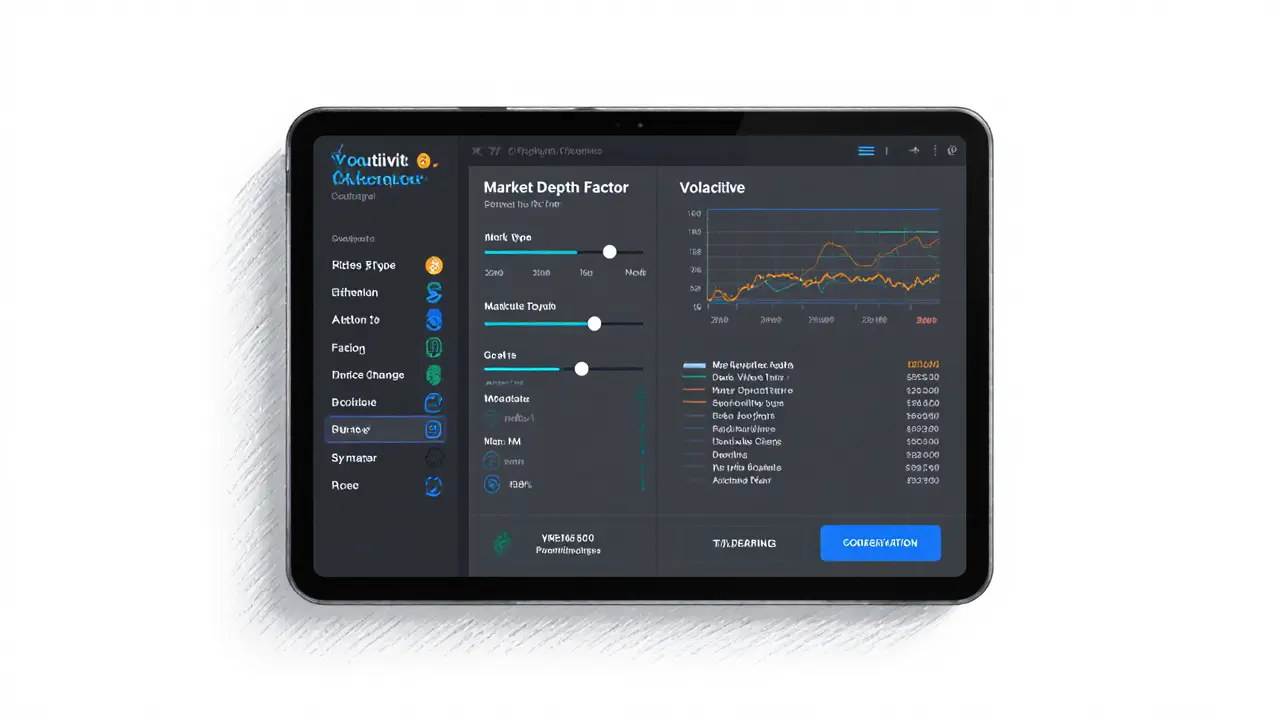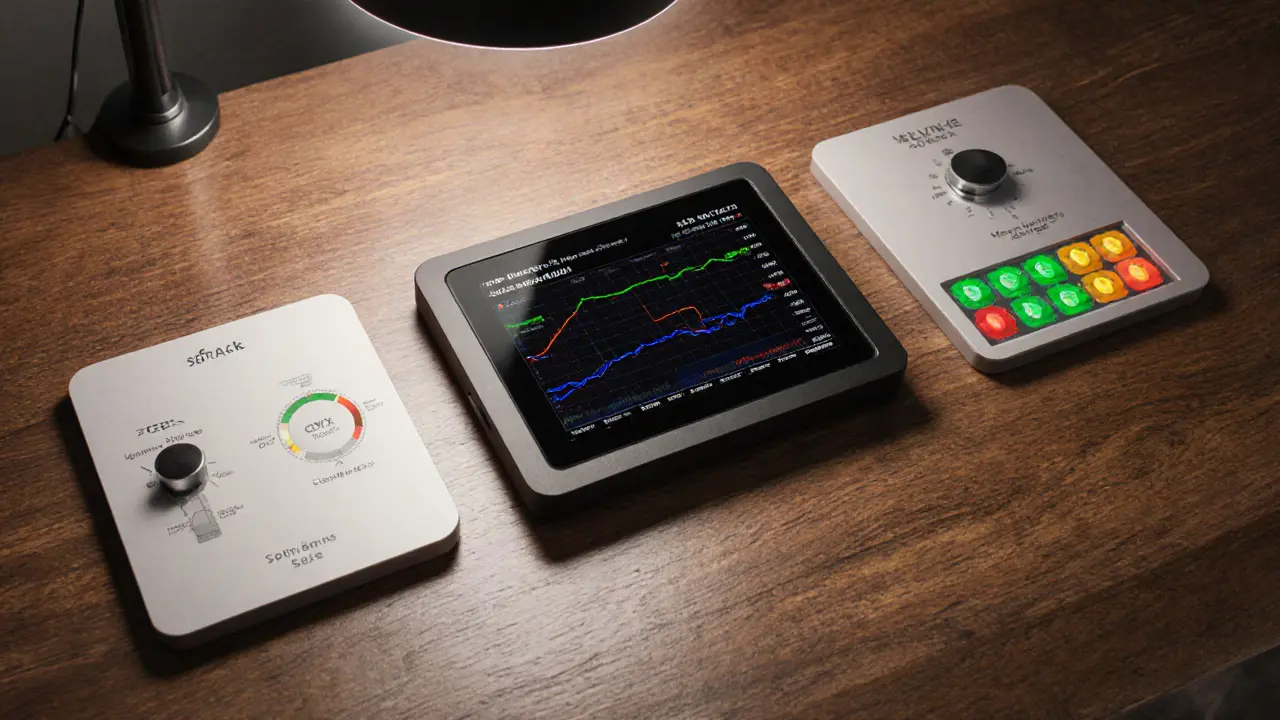Understanding Cryptocurrency Volatility: Causes, Measurement & Risks

Cryptocurrency Volatility Calculator
Input Parameters
Volatility Analysis
Risk Assessment:
Volatility level will be displayed here
Recommendations:
- Enter parameters to get personalized recommendations
When people talk about cryptocurrency volatility is the degree of price swing that digital assets experience over a set time period, they’re really describing the engine that makes crypto both exciting and terrifying. In the past few years the swings have gotten louder, but the reasons stay surprisingly consistent. This guide breaks down what volatility really means, how it’s measured, why it spikes, and what you can do to stay in control.
Defining the Beast
At its core, volatility is a statistical concept: it shows how far a price moves from its average. In traditional finance you’ll see volatility expressed as an annualized standard deviation of daily returns. For crypto the same math applies, but the numbers are usually three‑to‑four times higher than those you’d see in the S&P 500.
Because crypto markets are still young, a single large trade can shift the market dramatically. That’s why the phrase “high volatility” isn’t just a label - it’s a measurable risk factor that shapes every trading decision.
How Experts Measure Volatility
Two main flavors dominate the measurement toolkit:
- Realized volatility - calculated from historical price data. The formula looks at the standard deviation of log returns over a chosen window (daily, weekly, etc.).
- Implied volatility - derived from option prices, reflecting what traders expect future swings to be.
The Cryptocurrency Volatility Index (CVX) is the crypto world’s answer to the equity VIX. CVX pulls data from Bitcoin and Ethereum options, weight‑adjusts for market depth, and spits out a forward‑looking volatility figure. While VIX still dominates headlines for stocks, CVX is gaining traction as a benchmark for “how nervous” the market feels.
What Drives These Wild Swings?
Several structural factors make crypto different from stocks or bonds:
- Bitcoin has a hard‑capped supply of 21million coins. When demand spikes, the limited supply pushes price up faster than in an asset with elastic supply.
- Ethereum supplies are more flexible, but its transition to proof‑of‑stake still leaves short‑term uncertainty.
- Liquidity is thin for many altcoins. A single “whale” (large holder) can move a market by millions with a single trade.
- Regulatory uncertainty adds a news‑driven shock factor. A new rule in the U.S. or China can wipe out billions of market value in minutes.
- Retail sentiment, amplified by social media, leads to rapid FOMO (fear of missing out) buying and panic selling.
Each driver can act alone or combine into a perfect storm, which explains why volatility spikes often appear out of the blue.

Historical Flashpoints
Looking back helps put today’s moves into perspective:
- 2017 Bull Run - Bitcoin surged from $1,000 to almost $20,000 in twelve months, then fell 80% in early 2018. The rally was fueled by retail hype and limited market depth.
- COVID‑19 Crash (March2020) - Crypto fell nearly 50% in a single day, mirroring equity markets. The quick rebound highlighted crypto’s emerging role as an “inflation hedge”.
- 2021 Institutional Surge - Spot ETFs for Bitcoin and Ethereum entered the market, pushing the price to a $69,000 peak for Bitcoin. Subsequent corrections were driven by regulatory worries and tightening monetary policy.
- 2023‑24 Softening - Institutional ownership rose to roughly 6% of Bitcoin’s circulating supply, and realized volatility decreased by about 15% compared to the 2020‑2022 period.
These cycles show a pattern: explosive up‑moves followed by deep pull‑backs, then a gradual flattening as the market matures.
Crypto vs. Traditional Assets: A Quick Comparison
| Asset | Average Volatility % | Typical Drivers |
|---|---|---|
| Bitcoin | 85 | Supply cap, whale moves, ETF inflows, regulatory news |
| Ethereum | 78 | Staking transitions, DeFi demand, network upgrades |
| S&P500 Index | 18 | Economic data, earnings reports, monetary policy |
| Gold (COMEX) | 12 | Geopolitical risk, inflation expectations |
| VIX (Equity Volatility Index) | 22 | Market fear, macro shocks |
The numbers make it clear: crypto assets swing far more than stocks, bonds, or even gold. That extra swing is the source of both massive upside and crushing downside.
Living With Volatility: Risk‑Management Playbook
If you’re planning to put money into crypto, treat volatility as a daily reality, not an occasional surprise. Here are practical steps that work for both retail traders and institutional portfolios:
- Size Your Position - Keep crypto exposure between 1% and 5% of your total portfolio. This limits the impact of a single 70% drawdown.
- Use Stop‑Loss Orders - Set a price trigger (e.g., 15% below entry) to automatically exit a losing trade.
- Dollar‑Cost Average (DCA) - Invest a fixed amount every week/month regardless of price. DCA smooths out entry points and reduces timing risk.
- Diversify Within Crypto - Hold a mix of high‑cap (Bitcoin, Ethereum) and mid‑cap assets to spread liquidity risk.
- Monitor Volatility Indicators - Track the CVX and Bollinger Bands. When CVX spikes, consider tightening stop‑losses or reducing exposure.
- Leverage Spot ETFs - Spot ETFs lock in longer‑term holdings and reduce the need for custodial wallets, which can be a source of panic during market dips.
Combine these tactics with a clear mental plan: know your exit points before you enter a trade, and stick to them no matter how tempting the hype feels.
The Road Ahead: Will Volatility Calm Down?
Most analysts agree that as market cap expands and institutions claim a larger slice, volatility should gradually decline. The logic is simple: bigger markets digest large orders with less price impact, and long‑term holders (like pension funds) are less likely to panic‑sell.
However, three forces will likely keep crypto’s volatility higher than traditional assets for the next decade:
- Regulatory clarity is still evolving. Sudden policy shifts can still create short‑term spikes.
- New technologies (Layer‑2 solutions, DeFi protocols) bring fresh capital and fresh uncertainty.
- Retail participation remains strong. Even a modest influx of new traders can magnify sentiment‑driven moves.
In short, expect a slow tapering of swings but not a complete disappearance. Treat volatility as a built‑in feature, not a bug.

Frequently Asked Questions
What exactly is cryptocurrency volatility?
It is the statistical measure of how much a crypto’s price moves up or down over a set period, usually expressed as an annualized standard deviation of daily returns.
How does the CVX differ from the VIX?
CVX is built from cryptocurrency option data (mainly Bitcoin and Ethereum), while VIX uses equity options. CVX reflects crypto‑specific market fear, whereas VIX captures broader stock‑market anxiety.
Why do whales cause bigger price swings?
A whale can move millions of dollars worth of coins in a single transaction. Because many crypto markets have limited depth, that trade can shift the price several percent in minutes.
Is dollar‑cost averaging enough to protect me from volatility?
DCA smooths entry points and reduces timing risk, but it doesn’t eliminate downside. Pair DCA with position size limits and stop‑losses for a full risk‑management approach.
Will crypto volatility eventually match that of stocks?
Most forecasts suggest volatility will trend lower as markets mature, but it is likely to stay above traditional equity levels for the foreseeable future because of supply constraints, regulatory flux, and retail sentiment.

Dimitri Breiner
October 3, 2025 AT 18:12Really solid breakdown on volatility metrics - especially liked how you tied CVX to real trading behavior. I’ve been using Bollinger Bands + CVX spikes to adjust my DCA entries, and it’s cut my emotional trades by like 60%. No more FOMO buys at 3am.
LeAnn Dolly-Powell
October 4, 2025 AT 08:17YES!! 🙌 I started DCAing $50/week into BTC after reading this and my anxiety literally dropped. Even when it dips 20%, I just say ‘this is normal’ and keep going. Crypto isn’t a rollercoaster - it’s a really bumpy hike with amazing views. 💪✨
Anastasia Alamanou
October 4, 2025 AT 10:27From a portfolio construction standpoint, the 1–5% allocation guideline is non-negotiable for retail investors. The key insight here is that crypto volatility isn’t noise - it’s a feature of an immature market structure. When institutional ownership crosses 10%, we’ll see mean reversion kick in, but until then, treat it like venture capital: high risk, asymmetric payoff. Also, don’t forget liquidity risk in altcoins - many are effectively illiquid even if they have ‘high volume’ on paper.
Rohit Sreenath
October 5, 2025 AT 04:12People think crypto is money. It’s not. It’s a game. The rich play it. The rest lose. Simple.
Sam Kessler
October 5, 2025 AT 14:55Of course they downplay the real issue - the Fed’s printing presses are the only reason crypto even exists as a ‘store of value’. The whole ‘volatility’ narrative is just a distraction. Central banks are rigging the system. Bitcoin is the only escape hatch - and they know it. That’s why they’re pushing ETFs. To monitor you. To control you. To tax you. Wake up.
Steve Roberts
October 6, 2025 AT 13:56So you’re telling me that people should ‘dollar-cost average’ into something that’s basically digital gambling with a whitepaper? That’s not investing. That’s surrendering your financial agency to a hype cycle. And don’t get me started on ‘CVX’ - it’s just VIX with a blockchain sticker on it. Real investors don’t need indexes to tell them when to panic.
John Dixon
October 7, 2025 AT 09:05Wow. Just… wow. You actually wrote a 2,000-word essay on why crypto is volatile… and then recommended DCA? Are you serious? You’re not ‘managing risk’ - you’re just hoping the casino doesn’t kick you out before you win. 😂
Brody Dixon
October 7, 2025 AT 20:54I’ve been holding BTC since 2019 and I still get nervous during big dips. But I’ve learned to breathe. The math in this post is spot-on - especially the part about liquidity. I used to trade altcoins… now I just stick to BTC and ETH. Life’s so much calmer.
Mike Kimberly
October 8, 2025 AT 14:24It’s worth noting that the historical volatility patterns observed in crypto markets are not anomalies - they are the natural byproduct of decentralized, permissionless, global asset formation under conditions of regulatory ambiguity and asymmetric information. Unlike equities, which are anchored by cash flows, earnings, and legal frameworks, crypto assets derive value from network effects, speculative consensus, and technological adoption curves - all of which are inherently nonlinear and path-dependent. Therefore, the persistence of elevated volatility is not a flaw to be corrected, but a structural characteristic of emergent monetary systems. The gradual decline we’re witnessing since 2022 reflects institutional maturation, not market stabilization - and even then, it’s unlikely to converge with traditional asset classes due to fundamental differences in supply elasticity, governance mechanisms, and participant psychology.
angela sastre
October 9, 2025 AT 10:17Love this! I’m a teacher and I told my students about DCA last week - they all started investing $10 a week. One kid bought his first BTC with lunch money. 😊 Crypto isn’t magic, but it’s real. And if you treat it like a long game, it works.
Patrick Rocillo
October 10, 2025 AT 00:51Bro, this is the most chill and real take I’ve read all week. I used to be all in on memecoins - now I just DCA into BTC like it’s my morning coffee. No stress. No drama. Just vibes. ☕🚀
Aniket Sable
October 10, 2025 AT 21:38good post. i like how you say dca. i do dca too. even when price go down i keep buying. my wallet is small but i am happy. crypto is long term game.
Santosh harnaval
October 11, 2025 AT 15:16Volatility is just the cost of entry for decentralization. No need to overthink it.
Claymore girl Claymoreanime
October 12, 2025 AT 10:21Everyone’s so naive. You think CVX is a real indicator? It’s just a glorified sentiment gauge built by the same Wall Street firms that created the VIX. They’re using your fear to price options - and you’re handing them your money while calling it ‘risk management’. Classic.
Will Atkinson
October 13, 2025 AT 04:59Hey, I get where you’re coming from - but I think you’re missing the bigger picture. Even if CVX is influenced by institutions, it’s still the best real-time barometer we’ve got for crypto sentiment. Think of it like a thermometer for the market’s fever. Doesn’t mean it’s perfect - but it’s better than guessing. And hey, if you’re not using it, maybe you’re just flying blind? 😊
monica thomas
October 13, 2025 AT 12:03While the statistical methodology presented is sound, one must consider the epistemological limitations of applying traditional financial metrics to emergent digital asset classes. The assumption that standard deviation of log returns is a sufficient proxy for risk may be fundamentally flawed in non-Gaussian, fat-tailed environments such as crypto markets.
Edwin Davis
October 14, 2025 AT 00:26Why are we even talking about this? America’s economy is crumbling, and you’re giving advice on Bitcoin? We need real jobs, real infrastructure - not digital fantasy money. This is why our country is falling behind.
emma bullivant
October 14, 2025 AT 01:11so i read this and i think… volatility is like… life? you can’t control it but you can learn to dance with it? maybe? i dont know. my brain is tired.
Michael Hagerman
October 14, 2025 AT 02:47WAIT - so you’re telling me that when Bitcoin drops 30% in a day, it’s NOT a conspiracy? That it’s just… math? That I’m not being targeted by the Illuminati? 😭 I’ve been sleeping with a tinfoil hat for 3 years… I need therapy.